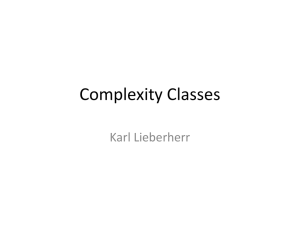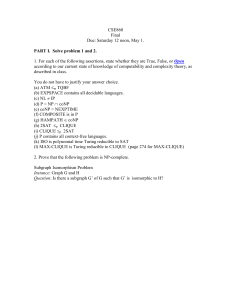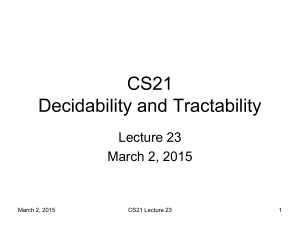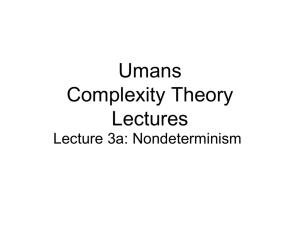Tsinghua
advertisement
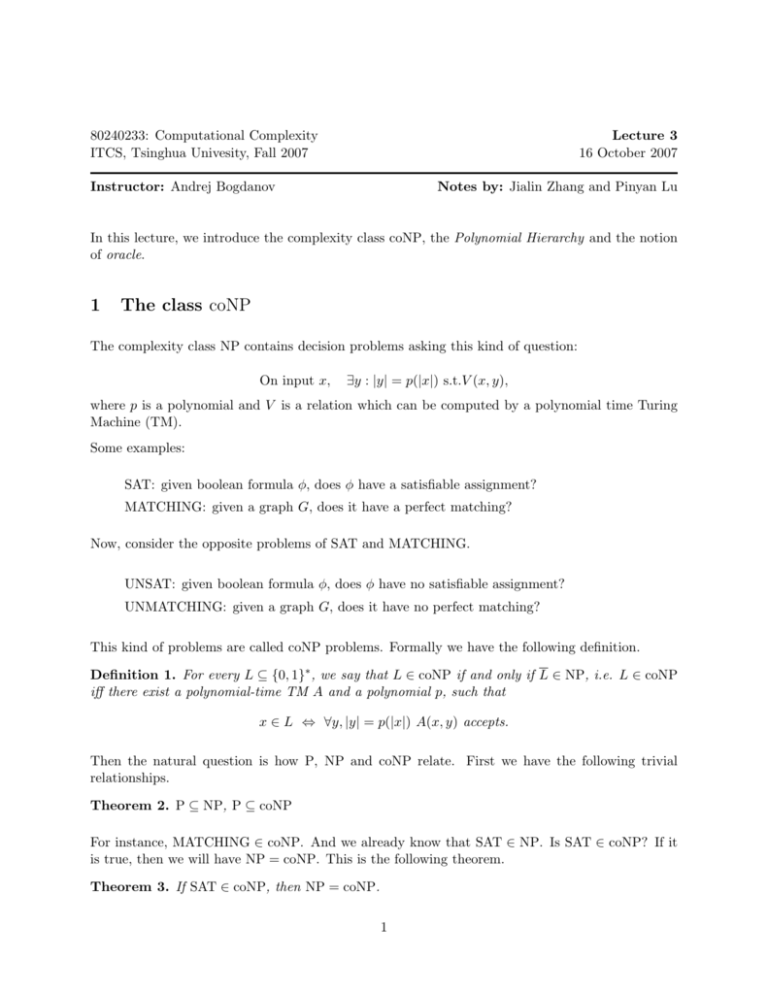
80240233: Computational Complexity
ITCS, Tsinghua Univesity, Fall 2007
Lecture 3
16 October 2007
Instructor: Andrej Bogdanov
Notes by: Jialin Zhang and Pinyan Lu
In this lecture, we introduce the complexity class coNP, the Polynomial Hierarchy and the notion
of oracle.
1
The class coNP
The complexity class NP contains decision problems asking this kind of question:
On input x,
∃y : |y| = p(|x|) s.t.V (x, y),
where p is a polynomial and V is a relation which can be computed by a polynomial time Turing
Machine (TM).
Some examples:
SAT: given boolean formula φ, does φ have a satisfiable assignment?
MATCHING: given a graph G, does it have a perfect matching?
Now, consider the opposite problems of SAT and MATCHING.
UNSAT: given boolean formula φ, does φ have no satisfiable assignment?
UNMATCHING: given a graph G, does it have no perfect matching?
This kind of problems are called coNP problems. Formally we have the following definition.
Definition 1. For every L ⊆ {0, 1}∗ , we say that L ∈ coNP if and only if L ∈ NP, i.e. L ∈ coNP
iff there exist a polynomial-time TM A and a polynomial p, such that
x ∈ L ⇔ ∀y, |y| = p(|x|) A(x, y) accepts.
Then the natural question is how P, NP and coNP relate. First we have the following trivial
relationships.
Theorem 2. P ⊆ NP, P ⊆ coNP
For instance, MATCHING ∈ coNP. And we already know that SAT ∈ NP. Is SAT ∈ coNP? If it
is true, then we will have NP = coNP. This is the following theorem.
Theorem 3. If SAT ∈ coNP, then NP = coNP.
1
2
Proof. Take any L ∈ NP, we can reduce L to SAT. Since SAT ∈ coNP, so there exists an coNP
algorithm for SAT. Therefore, there exists an coNP algorithm for L. So L ∈ coNP. So we proved
that NP ⊆ coNP.
For the other side, we have
L ∈ coNP ⇒ L ∈ NP ⇒ L ∈ coNP ⇒ L ∈ NP.
The first and last steps use the definition of coNP and the middle step use the result NP ⊆ coNP,
which is proved above.
To sum up, we complete the proof.
2
Polynomial Hierarchy
Here we consider a new problem MIN-EQUIV. Given a boolean formula φ, is φ the smallest formula
that computes the function φ? Formally,
φ ∈ MIN-EQUIV ⇔ ∀φ0 < φ, ∃x : φ0 (x) 6= φ(x).
The opposite problem of MIN-EQUIV is MIN-EQUIV. Given a boolean formula φ, is there a
smaller formula that compute the function φ?
There is no obvious notion of a certificate of membership. It seems that the way to capture such
languages is to allow not only an ”exists” quantifier (as in the definition of NP) or only a ”for all”
quantifier (as in the definition of coNP). This motivates the following definition:
Definition 4. Σ2 is defined to be the class of decision problems for which there exists a polynomialtime TM A and a polynomial p such that x ∈ L ⇔ ∃y1 ∀y2 A(x, y1 , y2 ) accepts, where |y1 | =
p(|x|), |y2 | = p(|x|).
Π2 is defined to be the class of decision problems for which there exists a polynomial-time TM A
and a polynomial p such that x ∈ L ⇔ ∀y1 ∃y2 A(x, y1 , y2 ) accepts, where |y1 | = p(|x|), |y2 | = p(|x|).
The polynomial hierarchy generalizes the definitions of NP, coNP, Σ2 , Π2 .
Definition 5. Σk is defined to be the class of decision problems for which there exists a Polynomialtime TM A and a polynomial p such that x ∈ L ⇔ ∃y1 ∀y2 · · · ∃/∀yk A(x, y1 , y2 , · · · , yk ) accepts,
where |yi | = p(|x|), i = 1, · · · k.
Πk is defined to be the class of decision problems for which there exists a Polynomial-time TM
A and a polynomial p such that x ∈ L ⇔ ∀y1 ∃y2 · · · ∃/∀yk A(x, y1 , y2 , · · · , yk ) accepts, where
|yi | = p(|x|), i = 1, · · · k.
The polynomial hierarchy is the class PH = ∪i Σi .
There are some basic observations about polynomial hierarchy:
3
1. P = Σ0 = Π0 ;
2. NP = Σ1 , coNP = Π1 ;
3. P ⊆ NP ∩ coNP ⊆ Σ2 , Π2 ⊆ Σ3 , Π3 ⊆ · · · ;
4. L ∈ NP ⇔ L ∈ coNP;
5. L ∈ Σk ⇔ L ∈ Πk .
6. ∀k, Σk , Πk ⊆ EXP .
We believe – but don’t know how to prove – that Σk 6= Σk+1 , Πk 6= Πk+1 , Σk 6= Πk and EXP 6=
Σk , Πk for all k.
There is a survey by Schaeffer and Umans[1, 2], which gives several nature complete problems for
Σ 2 , Σ 3 , Π2 , Π3 .
3
Oracle
Oracle is equivalent of subroutine in complexity theory. An oracle Turing Machine can be executed
with access to a special tape, where they can make queries of the form ”is q ∈ L” for some language
L and get the answer in one step. That is, oracle gives us functionality what we do not know how
to implement efficiently.
Definition 6. P A is defined to be all decision problems decided by Polynomial-time oracle TM
given access to oracle A.
Definition 7. NPA is defined bo be all decision problems decided by Nondeterministic Polynomialtime oracle TM given access to oracle A.
We already saw a special kind of oracle computation, namely a reduction. In a reduction the oracle
is asked only one question, and the answer to this question is the output of the algorithm. In
particular, if decision problem A reduces to B, then A ∈ PB .
Let’s play with oracles for a bit to get a feel about what they do:
1. What is PMATCHING ? This is just P, since any call to the oracle can be simulated by the
polynomial-time machine making the call. For the same reason NPMATCHING = NP.
2. How about PSAT ? A polynomial-time machine with a SAT oracle can solve any NP question
by Cook’s theorem – first reduce to SAT then ask the question. But it can also solve any
coNP question – again, reduce to SAT, ask the question, then output the opposite answer.
So we have PSAT ⊇ NP, coNP.
3. Since PSAT is more powerful than both NP and coNP, how does it relate to Σ2 and Π2 ? The
following theorem, implies that PSAT ⊆ Σ2 ∩ Π2 .
4
Theorem 8. NPSAT = Σ2
Proof. Step 1: prove Σ2 ⊆ NPSAT . For any L ∈ Σ2 , there exists a polynomial time TM V such
that x ∈ L ⇔ ∃y∀z V (x, y, z) accepts.
We can think ”∃y” part to be the nondeterministic tape of a NTM N . Once N guesses y, it
has to determine whether ∀z : V (x, y, z) accepts. We can ask SAToracle here, ”does there exists
z, s.t.V (x, y, z) rejects?” and output the opposite answer.
Step 2: prove NPSAT ⊆ Σ2 . For any L ∈ NPSAT , we are given an oracle Polynomial-time NTM N .
We need to simulate N SAT by ∃y, ∀z, V (x, y, z) accepts.
Nondeterministic tape of N is part of y in ”∃y” of V . When N makes an oracle call Φi , V keeps
trace of Φi , and guesses an answer ai to Φi . In the end, V will check ”Yes” answers(φi ∈ SAT)
and ”No” answers (φi ∈ UNSAT).
To sum up, we can define the Σ2 language as following:
∃y∃a1 , a2 , · · · , ak ∃v1 , v2 , · · · vk ∀w1 , w2 , · · · , wk V (x, y, a, v, w)accepts,
where V (x, y, a, v, w) accepts if and only if the following two conditions satisfy: (1) given input x,
nondeterministic tape y and the oracle’s answer a, N (x, y, a) accepts; (2) ai is a correct answer of
Φi , which means that for every i, 1 ≤ i ≤ k, either ai = ”Yes” and Φi (vi ) = ”Yes” or ai = ”No”
and Φi (wi ) = ”No”.
This argument gives an alternate characterization of the polynomial hierarchy using oracle machines, and it can be extended to higher levels of the hierarchy too:
1. coNPSAT = Π2 ;
2. Σk+1 = NPΣk −complete problem .
Since ”Σk SAT” is complete for class Σk , this means NPΣk SAT = Σk+1 .
The following table summarizes some conjectures people believe and the fact people prove about
polynomial hierarchy.
Believe
Fact
P, NP, coNP
P 6= NP
NP 6= coNP
P = NP ⇔ P = coNP
Theorem 9. P = NP ⇒ Σ2 = P
PH
Σk 6= Σk+1 for all k
Σk 6= Πk for all k
Σk = Σk+1 ⇒ Πk+1 = Σk+1 = Πk = Σk
5
Proof. Take any L ∈ Σ2 . This means x ∈ L ⇔ ∃y∀z, V (x, y, z) Accepts. We define another
language L0 : (x, y) ∈ L0 ⇒ ∀z 0 , V (x, y, z 0 ) accepts. So L0 ∈ coNP. By the assumption P = NP,
we have L0 ∈ P. This means there exists Polynomial-time TM V such that (x, y) ∈ L0 ⇔ V 0 (x, y)
accepts. Then, x ∈ L ⇒ ∃y V 0 (x, y) accepts. This means L ∈ NP = P.
References
[1] M. Schaeffer and C. Umans. Completeness in the Polynomial-Time Hierarchy: a compendium.
SIGACT News. guest Complexity Theory column. September 2002.
[2] M. Schaeffer and C. Umans. Completeness in the Polynomial-Time Hierarchy: Part II.
SIGACT News. guest Complexity Theory column. December 2002.
